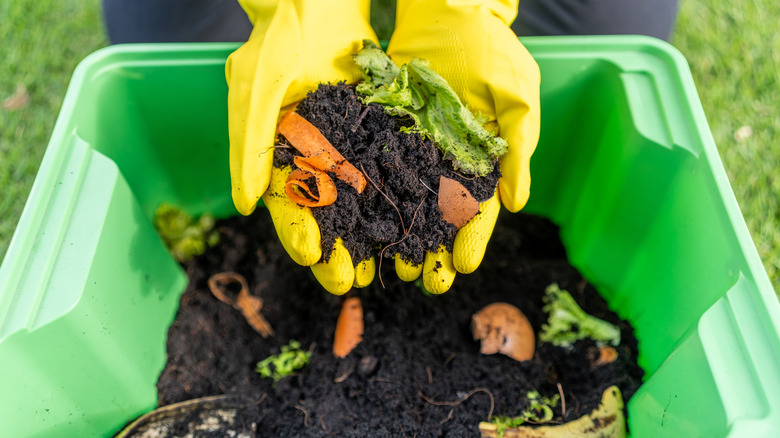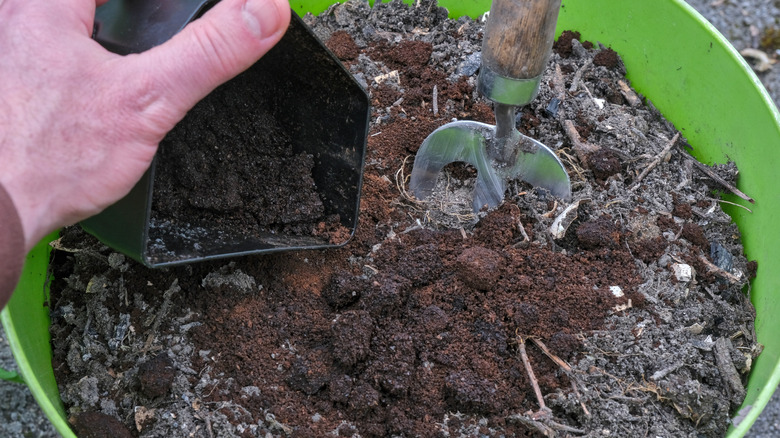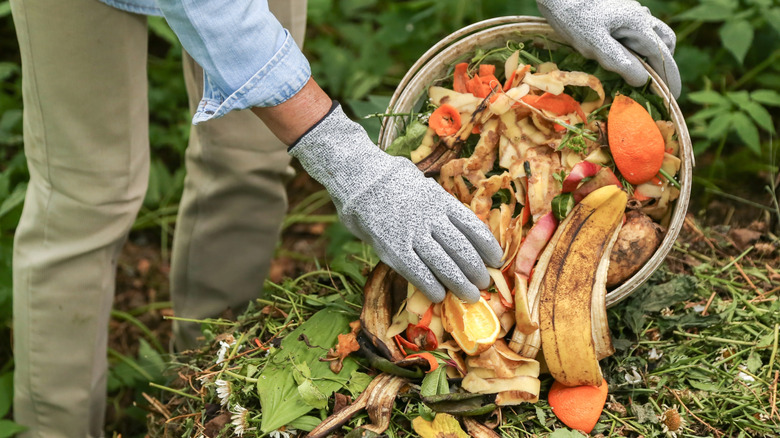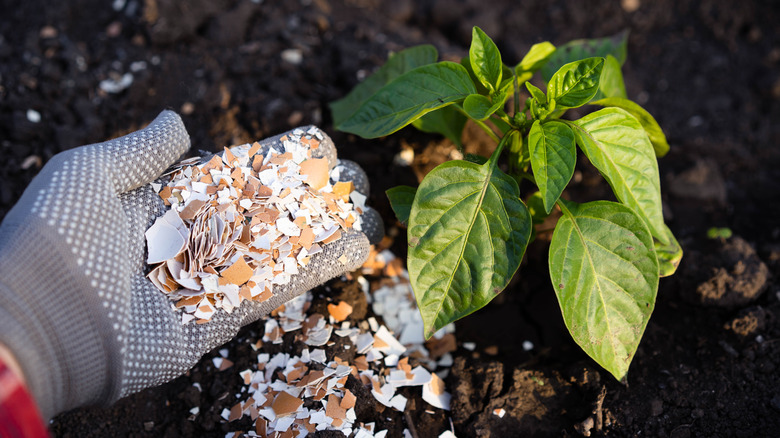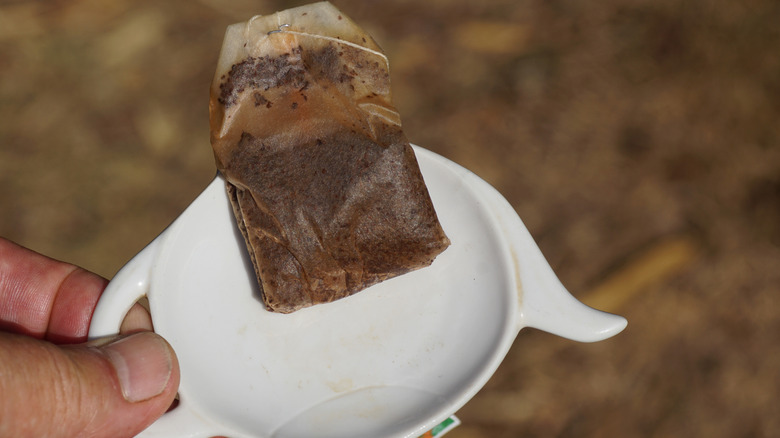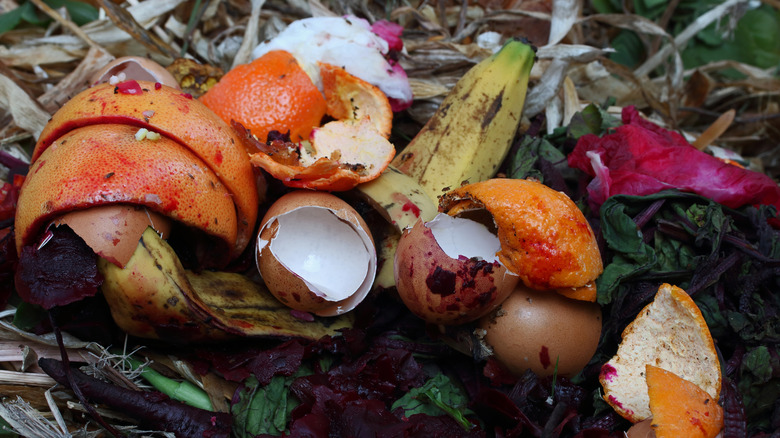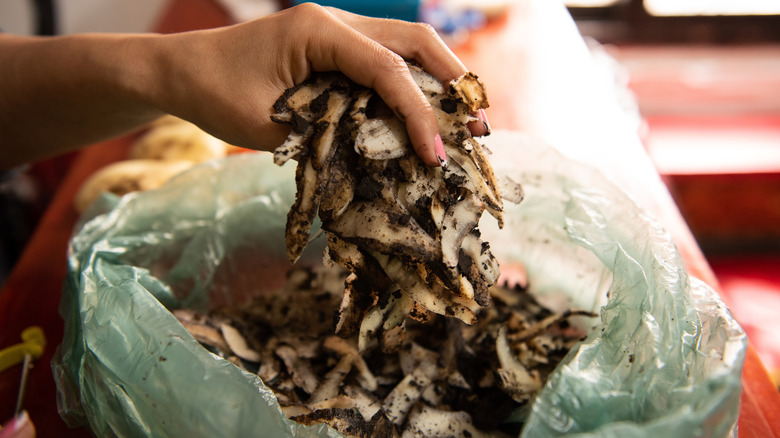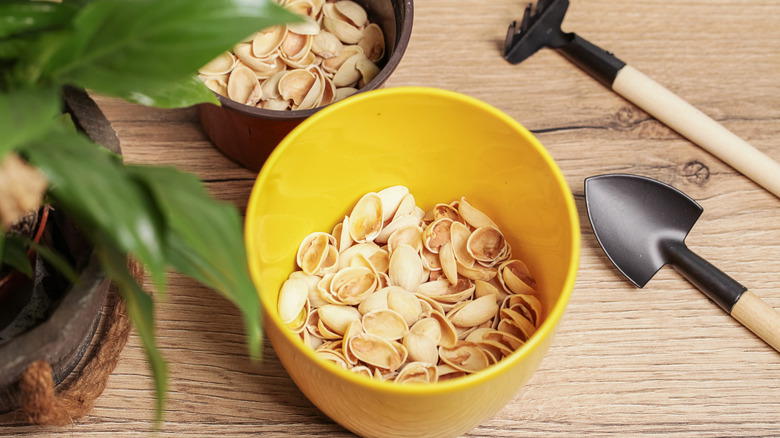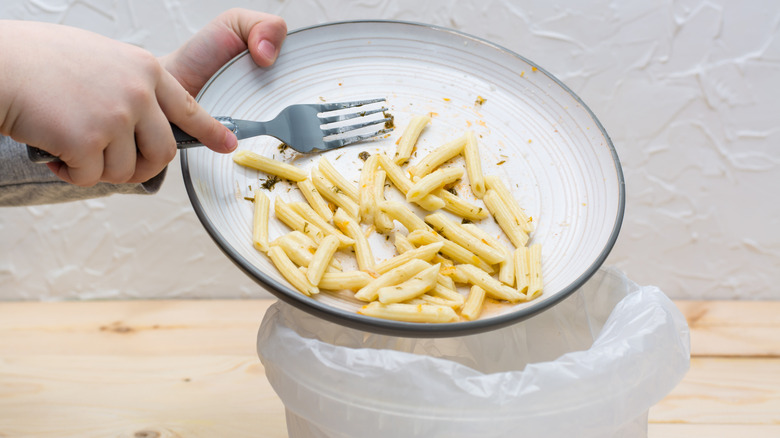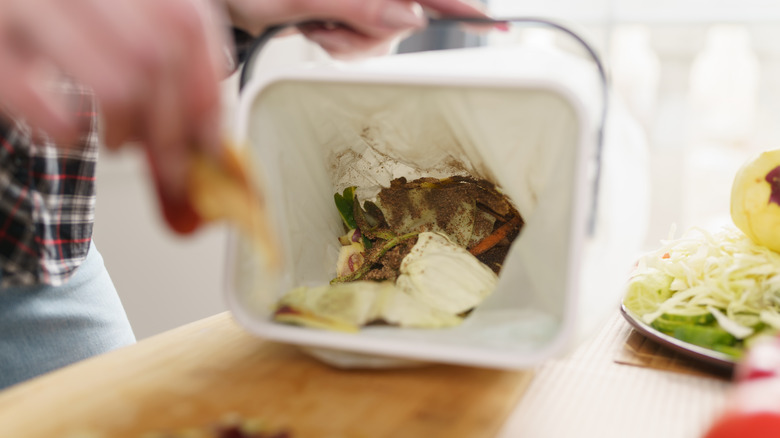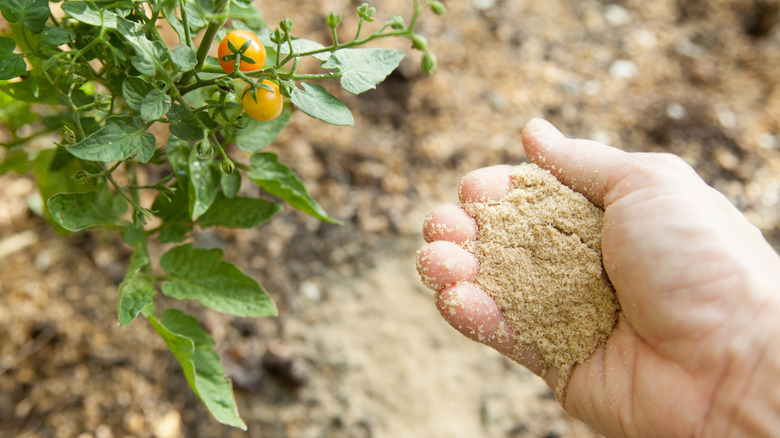Kitchen Scraps You Can Reuse In The Garden As A Natural Fertilizer
Ready to give your garden soil the biggest nutrient boost ever? Us, too! Enriching garden soil is a fantastic way to provide your plants with the food they need to grow, particularly if your in-ground soil isn't great or you accidentally bought the wrong type (we've been there, believe us). But fertilizers from big box stores can get expensive and may even end up giving your plants and veggies an overdose of nutrients, resulting in a whole mess of problems, like nitrogen burn, leafy growth, no crops, etc.
So, put the Amex away, because we've found 13 different food scraps you can use to give your soil the tasty bits it needs to make your garden thrive. Not only will these save you a few bucks, but fertilizing with food scraps reduces food waste, and it helps improve the soil's structure, which promotes strong root growth. But, we know it can get overwhelming, especially if you're a stickler for detail, (e.g. how many carrot peels are too many?), so we'll add a few caveats you should know, too. That way, you can do right by your garden plants on the first try.
Coffee grounds can add nitrogen to the soil
You've probably heard that adding leftover coffee grounds in garden soil is useful, but many sources are light on explaining why, so let's break it down. Coffee grounds are rich in nitrogen and have an NPK (nitrogen, phosphorous, potassium) rate of 21 – 0.3 – 0.3, which means they're like a 5-Hour Energy shot right into the soil. They also help the worms living in the soil, because they need a little grit to help break down food, and coffee grounds are just the right consistency to get the job done.
But, before you head out to the garden with your coffee maker's filter full of grounds, there are a few things you should know. First, giving plants too much nitrogen can be a bad thing that results in root burn or super-leafy growth instead of crops. It's like your plant has too much of a good thing and needs a way to get rid of it. Making fruits takes a lot of time, but leaves are much easier, so they direct the energy that way. Also, if your grounds are added thickly and caked on top of the soil, there's a chance it might hinder the roots being able to get the oxygen they need to grow — sort of like how compacted soil does. So, first get a soil test to ensure you actually need to add more nitrogen and then mix a little bit at a time into the soil instead of laying it over the top.
Vegetables and fruits that are past ripe make excellent worm food, both in bins and in the soil
Back in the old days, before municipal waste and trash collection, people would bury old vegetables or fruit scraps in the soil. While it might've just been a way to get rid of trash, it was incredibly effective at enriching the soil as a sort of slow-release fertilizer, returning the organic material back into the dirt as it decomposed. But fruit and veggie scraps have another benefit: They make excellent worm food. It's a method known as "vermicomposting" and is both an awesome way to reduce food waste and make worms happy. The worms produce castings, which is essentially worm manure that's super fertile. Therefore, happy worms equals fertile soil, so don't be icked out if you see a big worm wriggling near your scrap heap — it's a sign there's lots of goodies for it to feed on.
Most vegetables and fruit scraps can go into the soil, but you may want to skip citrus fruits and onions if you're focusing on vermicomposting. Both citrus fruits and onions have an acidity level that can kill off much-needed microorganisms and worms. Plus, too many of them leeching into the soil could disrupt its pH level. Typically, it would take a lot of acid to turn an entire garden bed into an acidic soil garden, but if you're just on the edge of neutral-to-acidic, then it's best to play it safe because soil acidity matters to the health of your plants — but save the citrus peels, because we're going to need those later.
Eggshells are useful sources of calcium
Eggshells are versatile additions to any garden. You can use them as biodegradable seed starting containers or add them to the soil as a fertilizer. Eggshells contain calcium, which some gardeners even believe can help stave off blossom end rot on tomatoes. As they decompose, they release all of that calcium directly into the soil, which plants use to create strong cells that can block dangerous pathogens from getting in.
But, there's a trick to incorporating eggshells to boost your garden's growth: You need to crush them up. Eggshells can take a long time to break down — which is probably why they make such good chick incubators — so just tossing them onto your garden bed won't do much. We recommend heading to the thrift store and looking for an old electric coffee grinder that you can use as a dedicated eggshell pulverizer. You can also use the grinder you've already got, of course, but may get the occasional egg powder in your morning cuppa.
Used tea leaves can also add nitrogen to soil
Speaking of cuppas, let's talk about what to do with your used teabags. Steeped tea leaves are full of the three essential nutrients plants need to grow: nitrogen, phosphorous, and potassium. Plus, they're a useful source of organic materials that help balance the carbon-rich "browns" in a compost heap. It's always a good rule of thumb to have a good mix of greens (nitrogen-rich additions) and browns in your compost pile to make sure that everything is well-balanced when it ends up near your plants.
Before adding your teabag to the compost pile, check to see if it's listed as compostable. Many bags are made from synthetic fibers and can either take a long time to decompose, or not decompose at all, trapping the organic material inside. There's also some evidence that these synthetic teabags can harm the vital worms your garden soil needs, so it's best to just skip them altogether and remove the tea from the bag instead. If you do have compostable bags, make sure to remove staples or glossy tags with colored ink before putting them in your soil or compost heap.
Create a banana peel ferment to feed plants
Banana peels are rich in two essential nutrients that your garden needs to deliver healthy plants: potassium and phosphorous. Phosphorous is used by plants to strengthen the plant by improving water efficiency, winter hardiness, root growth, and even seed germination. Potassium helps plants optimize their photosynthesis, helping them grow and fruit. If you've got a lot of perennial crops growing that need to make it through rough winters, banana peels are great additions that can help them come back strong every year.
The first step to using them is to remember to take off the stickers; they won't decompose. After that, cut the peels into small pieces. But, just tossing in a few cut up peels isn't going to work as well as you'd hope, because the potassium in the peels as-is isn't the right type for growing plants (it's complicated, we know). Some gardeners like to soak banana peels in water and use that as a P- and K-rich liquid fertilizer. However, the jury is still out on how effective banana peel water is at delivering potassium; many gardeners instead swear the trick is to ferment the peels. This involves weighing the volume of the banana peel and matching it 1:1 with brown sugar; the moisture already in the peels is enough, so don't add water. Mix the sugar and peels together in a bowl until you have a sort of banana peel sludge, then put that in a sealable jar and let it sit for about a month. The sugar will feed the organisms in the peels that help decomposition and will convert the unusable potassium into usable.
Citrus peels can be a slow-release source of nutrients for the soil and won't attract critters
So, citrus fruits don't do well when worms are the priority, but they can be useful in poor nutrient soils where worms don't live. A 2017 report in Restoration Ecology showed that adding orange peels and pulp to rocky, nutrient-light soils resulted in a 3x increase in the number of plants growing and a 176% increase of woody biomass, as compared to the control plot of land. The orange peels and pulp worked by delivering a mix of macro and micronutrients back into the soil, and were so good at their job that samples taken 16 years later still showed massive improvements.
If you want to add your citrus peels into the soil, start by cutting them up or using a zester; this will make them easier to decompose. Then you can either add them to your mulch or bury them at a shallow depth under the soil. Since these aren't typically foods critters like to eat, the chances of having them dug up by hungry animals is minimal, so you won't need to bury them very deep. Be aware of your soil's pH level, though, as their acidity could alter it if there's a high enough concentration. Keep in mind that these are best used to kickstart soil that's low in nutrients where things normally wouldn't grow; if you've already got good soil then it's probably best to skip and save your garden from the potential harm.
Potato peels add potassium and trace minerals to soil
Potato peels are fantastic sources of trace minerals that add a little oomph to your soil. A 2015 study in the International Journal of Renewable Energy Technology took a look at the mineral and chemical makeup of potato peels and found they contained copper, zinc, iron, magnesium, sodium, calcium, potassium, and phosphorous — all useful nutrients that contribute to strong plant growth. Plus, soil microbes benefit from their starch content to enhance nitrogen, making them useful as direct fertilizer or in the compost pile.
Most gardeners like to repurpose potato peels in the garden by creating a kind of potato water instead of putting the peels directly into the ground. To use this method, you'll need one part potato skins to one part water, along with a sealable jar. Don't use skins that are green, as these contain toxic glycoalkaloids. Add the skins and water to the jar and seal it, then let it sit. You'll want to give it a swirl every day just to make sure the water is getting all of those nutrients. Some people only leave the jar to sit for 3 to 7 days, but research shows that the sweet spot for maximum fermentation is 25 days. After that, strain the water and pour it at the base of your plants. You can them toss the skin into your compost heap.
Use fish scraps to add nitrogen and phosphate
Let's say you had a delicious salmon salad, but aren't the kind of person who likes to keep leftovers for long. Why not use those leftovers for the garden (assuming there's no dressing, of course)? Gardeners with fishermen in their families have been burying fish carcasses in their soil for years, since they're high in nitrogen and phosphorous. Plus, you can chuck them straight into the soil, no fermenting necessary.
But, we're pretty sure you can figure out what our caveat is going to be here: the smell. Decaying fish can get stinky and attract critters, large and small. Alaskan gardeners have reported finding a whole wildlife safari in their yards that run the gamut from flies to dogs and even bears — all of them coming to find that smelly fish they know is in the ground. So, to combat this, you should first ensure your garden is fenced in; one Alaskan gardener recommended an electric fence, but we think that's more for extreme circumstances and not necessary for urban gardens. Next, dig as deep of a hole as you're comfortable with and toss the fish scraps in, then cover it with lots of dirt. The deep hole will prevent shallow diggers from finding your scraps and will probably do a lot to prevent the fishy smell in your garden, too.
Nut shells can improve soil structure
Nut shells are like little wunderkinds for garden soil, because they do a ton of work. Not only do they improve the chemical makeup of your soil, increasing carbon, NPK, pH, and microbial activity, but they help improve the soil's structure, too. A 2018 study in Annals of Forest Science tested what would happen to soil infused with peanut shells and saw a notable increase in height, biomass, and chlorophyll production of their seedlings. Another study found pistachios made excellent replacements for vermiculite or perlite (which help with soil aeration, drainage, and moisture retention), which is awesome since both are non-renewable resources.
There aren't many specific guidelines to using nut shells, except you probably want to grind them down to make it easier for them to decompose. However, one big caveat is to avoid using walnut shells. Walnut shells contain juglone, a chemical compound that's toxic to some plants.
Pasta and rice add carbohydrates that feed soil microorganisms
Starchy products like pasta, bread, and rice might not seem like useful fertilizers, but they do more than you think. These starches add carbohydrates to the soil or compost, which feed the microorganisms in your soil. The microorganisms act like little soil sentinels for your plants, protecting them from diseases. They also help improve soil structure and can even sequester carbon — so they deserve a little starchy treat once in a while, don't you think?
To give the microbes their pasta dinners, you first want to make sure they're light on the oils or sauces, as these can attract pests (a wire mesh cover over your garden may also be a good idea). Also, use them sparingly; pasta, bread, and rice are all great at storing water, which can attract mold and bacteria that aren't beneficial for gardens. Your safest method is to add them to the compost heap that has a good mix of "browns" in it (as these carbs are high in nitrogen), or use a Bokashi compost system to ensure your soil gets all of the good stuff without also inviting the bad.
Meat, dairy, and leftovers can be converted into a potent fertilizer via Bokashi composting
Normally, meat and dairy products are a big no-no for soils, but there's a way to do it that reaps the benefits without the drawbacks: using the Bokashi compost method. Meat and dairy can add beneficial nutrients and organic matter to soils, which is great if you're trying to garden in an area that has poor soil. Meat, in particular, is high in nitrogen, which is perfect for revamping low-nutrient soil.
Whatever you do, do not bury scraps of meat or old cheese chunks directly into the soil; it's like ringing the dinner bell for critters. The best way to use these is by adding them to an indoor Bokashi compost system. Bokashi composting is awesome because it eliminates the smell that decomposing meat or dairy has and lets you create a nutrient-rich liquid fertilizer through fermentation without the giant, stinky compost pile outside. Plus, the meat's nitrogen can help break down other stuff in the bucket faster — it's a win-win.
Old bran can be used as a nutrient-rich soil amendment
If you've got some extra bran that you don't know what to do with, add it to your soil! Bran is high in protein, nitrogen, and carbohydrates, so it helps both the plants and the soil microbes gardens rely on. Wheat bran is also rich with phytic acid, which microbes can break down into phosphate. You can even use it in soil blends as a replacement for peat moss. A 1996 study found that a mix of 20%/80% bran to soil resulted in a medium that was perfect for growing tomatoes. And since over-harvesting of peat moss is adding to our climate change woes, it makes sense to help protect the mosses still existing in nature.
There aren't many caveats to use bran since it's pretty versatile; it works well in mulch, the compost heap, or even directly on the top layer of soil. You may want to keep the layer pretty thin if adding it directly to the soil, just to make sure it doesn't hinder growth once it's wet. Make sure you're using plain bran and not a bran-based cereal that's high in sugar or other additives.
Shells from your last seafood meal can be a slow-release source of nitrogen
Did you know that lobster shells can do more than just scare your nieces and nephews? It's true! The exoskeleton from oysters, crabs, lobsters, and some terrestrial insects contain calcium and chitin, which acts like a slow-release nitrogen fertilizer in soil. Also, if you've got a root-knot nematode infestation, adding exoskeletons to your soil will attract exoskeleton eaters. Once they've consumed that lobster shell, they'll need a new food source, and those nematodes look mighty tasty. Additionally, the shells contain calcium carbonate, which you can find in garden lime, which can be used to raise the pH of the soil if it's trending too acidic.
Like eggshells, it's best to crush your seafood shells into a fine powder so that they decompose quickly and release those goodies into the soil. Crushing them may also help reduce any residual fishy smells that attract vermin looking for their next meal. If you don't have a way to pulverize the shells, try burying them as deep as possible so that their scent doesn't attract scavengers.
